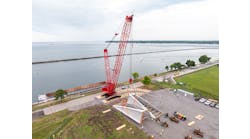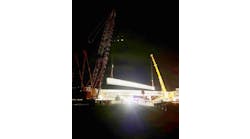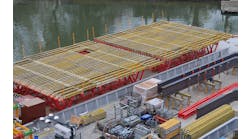By: Rodney Garrett
As a bridge-design class, movable bridges have four distinct types. All four types are well-represented in New York City, with 12 bascule bridges leading in number, followed by the seven swing-span bridges, four vertical-lift bridges and two retractile bridges. All 25 bridges are under the control of the NYCDOT.
Most of these bridges are of early 20th century vintage and the NYCDOT acknowledges that the lack of a consistently good preventive maintenance program for the past 75 years has impaired some bridges' moving functions. To correct these bridges' malfunctions and some potential safety hazard issues, NYCDOT is currently rehabilitating six of them, including replacing some bridge sections on the Third Avenue (swing) Bridge that crosses over the Harlem River. The bridge carries one-way southerly directed traffic starting in the Bronx by access ramps at Third Avenue, East 135th Street, Bruckner Blvd. and Lincoln Avenue Crossing the Harlem River and into Manhattan, the bridge has exit ramps to East 128th Street, East 129th Street, Lexington Avenue and the Harlem River Drive.
The Third Avenue Bridge was erected in 1898 at a cost of $2,794,268, replacing an existing swing bridge that was obsolete. Early in the 1900s an electric-powered motor replaced a steam-powered system for rotating the bridge's swing-span midsection, thus enabling craft and cabin cruisers to pass through to the other side of the bridge.
Despite the major construction and rehabilitation performed on the bridge in the mid-1950s, the NYCDOT recently decided some bridge sections needed to be replaced, including the swing-span midsection. It recently let a contract for $118 million to rectify all issues and work began in October 2002. NYCDOT projects the project will be completed by April 2005.
The project is being accomplished in five carefully planned stages so traffic can use some of the bridge's traffic lanes, albeit with traffic-flow efficiency compromised. At the later stages, a temporary bridge will serve the traffic while the existing bridge is shut down for the replacing of the midsection. With stage one completed in March of this year, stage two is now under way. This report deals with these first two construction stages and, more specifically, with the construction of the new piers.
The Third Avenue Bridge is a cantilever truss bridge with 31 spans that includes the 300-ft-long swing-span midsection. Its overall length is 2,800 ft and it features two divided, 26-ft-wide dual traffic lanes that form the complete roadway. Running parallel on either side of the roadway are two 9-ft-wide sidewalks.
The engineering firm Hardesty & Hanover LLP, headquartered in New York City, is heading the design and details of the project for the NYCDOT. Pointedly, the project calls for the replacement of the swing-span midsection and 1,351 ft of approach spans. The firm also designed the temporary bridge, which will be built sometime next year.
Drilled shafts by choice
For building the new poured-in-place concrete piers, it was decided by Hardesty & Hanover that the drilled shaft method be used. A total of 22 shafts are being sunk by the installed pipe/excavation method with each shaft being 6 ft in diam. and a nominal depth of 110 ft.
The contractor for this project is Kiska Construction Corp.-USA, which has been involved in the rehabilitation of many other New York City bridges over the past 12 years. Kiska brought in a foundation drilling specialist, HUB Foundation Co. Inc., for installing the pipe (caisson), excavating the ground inside the installed pipe, drilling a socket into the bedrock, installing rebar cages and placing the concrete to fill the pipe (shaft). This set of rounds essentially completes the construction of one pier.
HUB, a 37-year-old company from Harvard, Mass., had specialized in pile driving in the earlier years of its existence but has been focused on shaft drilling since 1990. Jim Maxwell, president, said he purposely redirected the company toward foundation drilling and has completely gone out of the pile-driving business. His reason for these actions is based on his belief that the shaft-drilling technology will become more popular as design engineers and project owners realize the attributes associated with this construction method.
According to Maxwell, one of the attributes is the elimination of noise pollution that is associated with pile-driving activities. When installing pipe (caissons), the vibratory hammer transmits its vibrations to the pipe at amplitude level that creates relatively little projected noise. Eliminating the noise is especially important if the pile driving takes place near residential areas, hospitals or nearby commercial venues. Depending on the construction conditions, shaft-drilling methods can be competitive with pile-driving methods, he said.
With the company's firm commitment to foundation drilling, Maxwell sits on the board of directors of the International Association of Foundation Drilling, Dallas. This organization has an in-house training school where HUB people are trained. Maxwell said with drilled shaft applications increasing he readily acknowledges more formally trained contractors will be needed to meet this growing demand.
King Kong returns to Manhattan
"This is the most challenging project I have encountered. And it takes big, high-producing equipment to carry it out efficiently. In fact, I brought King Kong back to Manhattan," said Maxwell, smiling. King Kong is the name of a big vibratory hammer being used on the project.
Here is why big equipment is needed to install the pipe. For each pier there are two 50-ft-long pipe sections required, where one is stacked vertically and welded on top of the other for building the shaft and acting as the concrete form for placing ready-mix concrete. The pipe wall is .75 in. thick and made from type A-252 grade-2 steel.
Once the first 50-ft length has been driven with the vibratory hammer, the ground inside the pipe is excavated using a drill rig fitted with an auger drill bit. Following the excavation, the same drill penetrates 20 ft deeper below the bottom of the installed pipe to stir up the ground. This ensures there are no obstructions to be encountered when driving the pipe farther down once the second 50-ft section is stacked and welded in place. Essentially, the two pipes are welded for making one pipe length from its top to the bedrock. When the pipe meets the bedrock, a socket is drilled into the bedrock 10 to 15 ft and the pier is anchored with the poured-in-place concrete.
For vibrating the pipe into the ground, two heavy-duty machines were brought together. Maxwell was very careful in selecting this equipment for the project. In the future, the equipment will be used on other projects as well. One of the pieces is the APE King Kong model 400 hydraulically operated vibratory hammer with a patented clamping system used for large-diameter caissons. It is one of the bigger hammers offered in North America. The hammer manufacturer, American Piledriving Equipment Inc. (APE), Kent, Wash., offers yet a larger model, the APE 600. APE has its own school for training contractors comprehensively on pile driving and deep foundation applications. There is even a distance learning course that can be taken over the Internet.
A vibratory hammer with a 4,000 in./lb moment capacity was first tried on the project prior to the delivery of the King Kong, but Maxwell said no appreciable production results could be achieved. By comparison, the APE 400 eccentric moment capacity is 13,000 in./lb. Maxwell said the production results using the King Kong have been outstanding. A 50-ft length is driven into the ground in about 10 minutes unless significant obstructions are encountered.
King Kong is big in every sense of the word. It has to be built heavy-duty to ensure it will stay together despite the high eccentric moment output and its drive force of 360 tons. The suspended weight of King Kong is over 18 tons.
The other half of the pipe-driving equipment is a new Liebherr HS 895 HD hydraulic crawler crane, which HUB Foundation recently bought. The value of the new duty-cycle crane is it can do anything a conventional lift crane can do and yet perform duty-cycle work that the lift crane cannot do well. Simply, it is a more versatile crane.
One of the unique features of Liebherr duty-cycle cranes is the available built-in power packs. They are available in different capacities, depending on the applications. This crane has one of the biggest output-capacity power packs available from Liebherr to ensure an oil delivery rate that is commensurate with the King Kong hammer's demand. The maximum hydraulic oil delivery rate is 264 gpm which is powered by the crane's 805-hp engine. The high horsepower and oil delivery capacity are ample to power the power pack and all other crane functions simultaneously.
A built-in power pack has two main advantages over the traditional set-alone type. It frees up the space normally required to station a set-alone power pack. Instead this space can be used for work activities or storage. The added work/storage areas are especially welcome when the crane is working from a barge, as it is on this project. Another important advantage of the built-in power pack system is it is controlled from inside the cab by the operator and is part of the crane's maintenance program.
So far, the choice of using the drill-shaft method has proven to be successful.
Since the crane can be used for duty-cycle or lift work, it can be used as a lift crane between drill-shaft projects. Maxwell will be renting the crane to Kiska once he has completed this project's pier work. Kiska wants the crane to remain here for lift work at the bridge project because the company can eliminate mobilization costs. Next year, Maxwell will come back to do some additional pier construction, so leaving the crane here will mean no additional mobilization costs.
With the Third Avenue Bridge project going so well, the NYCDOT, as well as other government agencies and private-sector owners, are sure to use this system on their projects.


